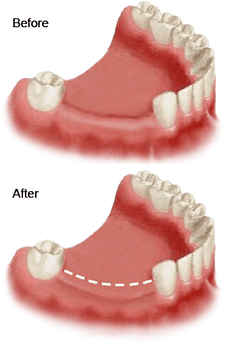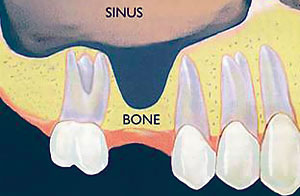Sinus Lifts and Bone Grafting for Dental Implants in Bradenton and Sarasota

Bone grafting and sinus lifts are typically done before a dental implant procedure takes place, when there is not enough foundational bone to support the dental implant needing to be placed. It can also precede a variety of other procedures. Come see our highly skilled experts in the Bradenton and Sarasota areas.
Skilled Regeneration of Lost Bone
- The Causes of Bone Loss
- How Bone Grafting Works
- Advanced Technology for Minimally Invasive Procedures
- When We Do Bone Grafting
 Your teeth are anchored in sockets on a platform of bone known as the alveolar ridge. Strong connective tissues (known as ligaments) and the surrounding bone firmly support your teeth and keep them stably in position on the ridge.
Your teeth are anchored in sockets on a platform of bone known as the alveolar ridge. Strong connective tissues (known as ligaments) and the surrounding bone firmly support your teeth and keep them stably in position on the ridge.
For various reasons, bone around your teeth can lose its volume and density. This can cause a variety of oral health problems, such as painful chewing and the loosening or loss of teeth. It can also be a stumbling block to placing dental implants, as implants need a certain amount of bone to be properly supported. Fortunately, Drs. Ryan, Tyler, and Thomas Rubino are able to regenerate lost bone and preserve your teeth and jaw through bone grafting.
Expert bone grafting specialist
As a periodontist, your doctor is a highly trained specialist in grafting procedures that regenerate lost bone. They keep current with the latest research and advancements in bone grafting techniques so you will be provided with the highest quality treatment at all times. The use of advanced technology and materials makes bone grafting treatment precise, minimally invasive and efficient.
The Causes of Bone Loss
Below are the main causes of bone loss around your teeth:
- Gum disease – Bacterial plaque and calculus (tartar) emit toxins that eat away the ligaments and bone tissue surrounding the teeth. As the disease progresses in severity, the bone loss worsens until there is little or no support left for the teeth. This causes teeth to eventually be lost.
- A missing tooth – The bone surrounding your teeth needs stimulation from biting and chewing pressure to maintain its volume and density. When a tooth is missing, that pressure is absent and the bone gradually dissolves away.
- A misaligned tooth – A tooth can be misaligned so that it does not make contact with the teeth in the opposing arch when you bite down. This sometimes severely reduces chewing and biting pressure (which is needed to maintain the bone around the tooth) and can lead to bone loss.
- Infections in your jaw – Tumors, bacterial or viral infections not caused by gum disease can develop in the bone tissue surrounding your teeth and can result in bone loss.
- Injury to the tooth – Tooth injury can cause the tooth to be thrown out of its proper position or become infected. Either the misalignment or the infection can lead to bone loss around that tooth.
How Dentures Accelerate Bone Loss
Dentures do not provide the stimulation needed to maintain the volume and density of your jawbone after your teeth are lost. In fact, the pressure exerted on your jaw by regular dentures actually accelerates the rate of bone loss and wears away the ridge of bone in your jaw. As the bony ridge dissolves away, your jaw loses height and thickness and literally shrinks. This can eventually cause the lower third of your face to get a “collapsed” look.
If you are wearing a traditional denture, the shrinking of your jawbone makes it necessary to continually refit the denture. The recurring lack of fit causes sore spots on your gums and can make chewing painful. It can get to a point where the bone loss is so severe that no denture will be able to fit snugly.
How Bone Grafting Works
 Bone grafting material is placed into the area where bone is missing in order to generate new bone tissue. Graft material can be taken from the patient’s own bone, from a human tissue bank or from another biocompatible source.
Bone grafting material is placed into the area where bone is missing in order to generate new bone tissue. Graft material can be taken from the patient’s own bone, from a human tissue bank or from another biocompatible source.
The graft material itself does not actually become the new bone. It stimulates the growth of new bone tissue by the body and acts as a “scaffold” (platform) around which the new bone can grow. The bone graft material itself harmlessly dissolves away as the new bone tissue fills the space.
Advanced Technology for Minimally Invasive Procedures
We use cutting edge technology in order to provide the most efficient treatment, with minimal down time.
Digital x-rays and 3-dimentional CT scans
Digital x-rays and 3-dimentional CT scans will be taken to inspect the bone levels around your teeth. When needed for even greater detail, additionally a 3D CT scan will be taken of your entire jaw with our cone beam 3D CT scanner.
The scanner produces crisp 360° digital images of your entire jawbone, teeth, and surrounding structures. These images can be viewed from any angle and magnified to get a closer view. 3D images can show the exact density and volume of the bone that surrounds your teeth.
Using these digital images, your doctor is able to precisely plan any necessary bone grafting procedures ahead of time and place the grafts efficiently.
Piezosurgery device for minimally invasive bone preparation
Sometimes some diseased bone tissue needs to be removed or the bone grafting site needs to be made into the optimum shape for a graft to be placed. Using a piezoelectric surgery device Drs. Ryan, Tyler, and Thomas Rubino can gently sculpt the bone to accomplish this.
This instrument generates a microvibration that precisely sculpts bone but does not affect the surrounding soft tissues. This greatly minimizes trauma, is more precise and efficient, and makes the procedure minimally invasive.
Why Bone Grafting is Performed
Bone grafts are placed to rebuild support for compromised teeth, to rebuild the structure of the jaw after tooth loss and to ensure adequate bone support for a dental implant.
To build support for a compromised tooth
A tooth that has lost supporting bone can become unstable and this can eventually lead to loss of the tooth. Bone graft material can be placed in the area of bone deficiency and rebuild proper support for the tooth.
To preserve the ridge after tooth extraction
After a tooth is extracted, bone loss tends to occur around the empty tooth socket. Drs. Ryan, Tyler, and Thomas Rubino will place a bone graft into the empty socket and generate the bone needed to preserve the ridge at its proper height, width and density. The regenerated bone will help support the adjacent teeth, and will simultaneously provide the necessary foundation for a future dental implant.
To build bone support for an implant
A dental implant needs adequate bone structure to be placed securely. When a tooth has been missing for a long time, bone loss has often occurred to such an extent that bone needs to be regenerated before an implant can be placed. When needed, a bone graft procedure will be performed so there is adequate bone for the implant to be stably anchored.
To augment the sinus cavity floor with a sinus lift
There are sinus cavities above the back teeth in your upper dental arch on each side of your face. When you lose a back tooth in your upper arch, the bone around the missing tooth causes the floor of the sinus cavity to “drop.” This bone loss can make the bone too shallow to support the full length of a dental implant.
In order to remedy this, bone graft material along the sinus cavity floor will be placed to regenerate the lost bone. This bone grafting procedure is known as a sinus lift.
This makes the bone under the rear teeth deep enough for implants to be placed securely. Using a piezoelectric surgery device—a special surgical instrument that is effective on hard tissue while leaving soft tissue undisturbed—your doctor can gain access for the bone graft. This makes the procedure fast and minimally invasive.
Call to request an appointment: Sarasota/


